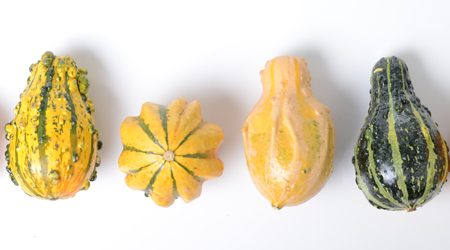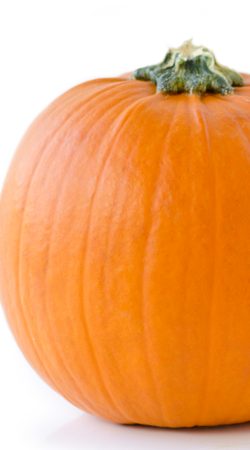Weird shapes, hard shells, awkward textures and the odd scientific name gourd – all point to a classic case of “don’t judge a book by its cover.” Gourds are a family of familiar fruits that no matter the season, offer some of the most delightful dishes despite their outside appearance. From pumpkin and squash to the popular summer favorites such as watermelon, cucumbers, zucchini and melons, gourds are a unique ancestry that showcase it is what’s inside that really matters.

A Little History about the Gourd Family
Normally confused with vegetables, gourds are actually a family of various fruits. Merriam-Webster defines the gourd as: any of a family (cucurbitaceae, the gourd family) of chiefly herbaceous tendril-bearing vines including the cucumber, melon, squash, and pumpkin. The family of fruits is primarily found in warmer temperatures and carries a great economic importance in the many regions the varietals grow. The sizable edible fruit gourds allow it to be a sustainable food source. The gourd family tree is composed of many branches and leaves – there are over 900 species of gourds with approximately 100 different genera according to several sources. However, three main types of gourd in this lineage exist – loofa (sponge gourd), lengaria (hardshell/ornamental gourd), and cucurbita, also known as cucurbit.
A Breakdown of Your Favorite Cucurbitaceae
Most people enjoy squash, pumpkin, melon, cucumbers, zucchini and the like. The genera cucurbit and cucumis are the two kinds of cucurbitaceae which source these consumable gourds. A further understanding of where gourds derive from makes this fruit family all the more interesting. Generally, cucurbits are divided into four perspective categories of annual blossoms:
Pepo:
This part of the gourd family is composed mostly of summer squash such as zucchini, yellow crookneck and scallop squashes, but also produces varieties of winter squash including acorn squash and spaghetti squash. Additionally, the most common varieties of carving and baking pumpkins showcasing a deep orange hue spawn from this line. Normally, the pepo species yields fruit that is small in size and consumed during its immature stages. This group produces multicolored fruit in yellow, green, white and blue colors with varying striations, sizes and shapes as well as hard, woody stems accented with grooves.Moschata:
According to the University of Illinois Extension site any squash having hard rinds and elongated recurved necks are considered a Moschata gourd. They are known for being utilized as canned pumpkin pie filling, because their flavor profiles are typically sweet and they contain orange flesh. Furthermore, these plants have a distinguishing feature of smooth stems with deep ridges and develop in shapes ranging from globule to flattened.Maxima:
The name speaks for itself. This segment of cucurbits produces characteristically large fruit that can weigh up to 400lbs. This species is composed mostly of winter squash such as Hubbard and Turban squash. The Maxima also stands out due to its yellowish skin, soft, spongy stem and catchy names such as Big Max and Show King.Mixta:
Bearing a mixture of characteristics such as fruit with hard to soft rinds in a myriad of colors, these cyndrical, curved fruits are accented by their decorative bulbs and hard, warty rinds that showcase gray, green or white stripes. The cucumis is also an annual blossom that bears the cucumber and produces several varieties of melon including cantaloupe and honeydew. WalterReeves.com, a site produced by garden expert, writer, radio and television host Walter Reeves, breaks down the family of gourds with a listing of each gourd belonging to the subfamilies listed above.
 Menu Planning & Nutrition
Menu Planning & Nutrition
In America, pumpkins are commonly recognized as a carved homage to the ghoulishly festive Halloween anniversary or as a staple on the holiday dessert table in the form of an irresistible spiced pie. Gourds are not just for the holidays, however, they are meant to be enjoyed any time of year. The flavor, nutrition and innovation gourds can offer make them prime candidates to be staples on menus. Beverages such as cucumber mint tea, pumpkin smoothies or watermelon mojitos are unique and trendy in today’s restaurants. Pastries such as zucchini bread, butternut squash tarts and pumpkin pannacotta are additional palate teasers to contemplate. Pumpkin-based baked macaroni and cheese, yellow squash with green zucchini, and butternut squash soup are examples of savory dishes that are both nutritious and satisfying. Appetizers and other desserts include watermelon and tomato summer salad, tossed melon salad with passion fruit topping and pumpkin gelato. The many varietals of gourds present numerous options to chefs wanting to create new and seasonal dishes in their kitchen. Not only do they add great flavor, but pack a healthy punch as well.
Keep in mind that gourds are generally a great diet staple. Gourds, in general, are low in calories, high in fiber and rich in vitamin and nutrient content. Gourd seeds such as pumpkin are high in protein, iron and B vitamins, and are delicious raw, toasted or pressed to make oil.
The Artistic Side of Gourds…
The shell of the gourd is also the canvas for many artistic pieces as displayed year-round at gourd and food shows across the nation. Amazingly, cups, ladles, dippers, bowls, plates, vases, baskets and boxes have been crafted from the shell of a dried gourd. Musical instruments such as the banjo, flute, rattle, drum and kazoo have also been artfully manufactured after the process of drying a gourd shell has been completed. This procedure can take from two to six months depending on the size of the gourd. And, we can’t forget the artists that use gourds to design beautiful hand-carved themed sculptures. Groups of gourd art enthusiasts like that of the American Gourd Society actively promote all activities relating to gourds including craftwork and artistic decoration. A dried gourd will last for years, allowing the art to be appreciated long after it’s created.
Gourds are simply unique. Each and every part of a gourd can be utilized, making it a versatile fruit. The varieties of gourds truly represent each and every season, promising inspiring culinary dishes as well as pristine artistic décor. They are a fruit that may not always look perfect on the outside, but gourds hold a rich family history and have intrigued both our taste buds and creativity over the years. We can expect they will only continue to do so for many more.
